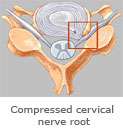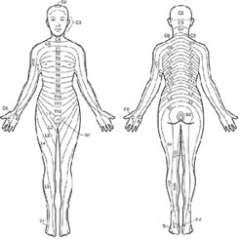Radiculopathy (Cervical and Lumbar)
Find your care
At the UCLA Health Spine Center, our experts diagnose, manage and treat all spinal injuries and conditions. Call 310-319-3475 to connect with a spine specialist.
Fax: 424-259-6560
What You Should Know About Radiculopathy
Degeneration of the spine can result in a variety of problem-causing conditions. Usually, they either come from mechanical problems in the neck or from nerves being irritated or pinched. A Cervical Radiculopathy (Pinched Nerve) results when a nerve in the neck is irritated at the point where it leaves the spinal canal and is most commonly due to a bone spur or disc herniation. Lumbar radiculopathy develops in the same way, and involves a nerve root in the low back. Usually, it happens when a herniated disc or a bone spur pinches a nerve root.

Symptoms
Weakness, tingling sensations in the neck and arm (cervical) or back and leg (lumbar), numbness, and loss of reflexes may all occur. These symptoms may worsen when the neck or back is in different positions such as flexion and extension. In lumbar radiculopathy, it may increase along with abdominal pressure from sneezing, laughing, coughing, or going to the bathroom. The distribution of sensory symptoms may follow a discrete pattern specific for each nerve root involved. We call this sensory distribution on the skin a dermatome, and it helps diagnose where the injury is.
![Disc Compressing a nerve root [red area]](/sites/default/files/styles/max_width_004000_160/public/images/9n_1.jpg?f=5490abc7&itok=Ldce_CCN)
Diagnosis
X-ray, MRI, or CT may all be used. Testing such as EMG/NCS may also be performed to examine the "electrical system" of the body and determine the severity of nerve compression.
Treatment

Treatment may consist of physical therapy modalities, injections, or medications. Surgery is necessary in cases involving neurological decline.